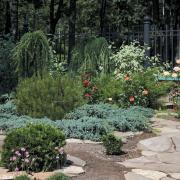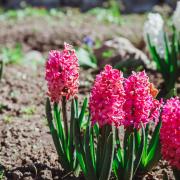Clematis is said by many to be the ‘Queen of Climbers’. There is a clematis for every season; the winter flowering varieties bring a fragile beauty, spring clematis such as the alpinas and montanas give us abundant flowers when other plants are yet to wake from hibernation, and the large flowered summer clematis wow us with blooms up to 15cm across in a wide range of colours. But the late summer and autumn flowering clematis offer us fresh colour when the garden is sometimes in dire need of ‘perking up’, especially if we have been enjoying extended dry and sunny weather.
True late flowering clematis will have their main, showy display from now on, some even offering fluffy seedheads which persist well into winter. C. ‘Jackmanii’ is a favourite. Growing from the ground in one season, to cover a wall or fence, it is covered in rich purple flowers for several weeks. Another old favourite is ‘Perle D’Azur. Bred in the 1880’s, its sky-blue flowers have never been out of fashion. Fast forward a century and C. Polish Spirit (mauve flowers) bred in 1984 has cemented itself over the last forty years as one of the best autumn clematis and has the RHS Award of Garden Merit. It tolerates poorer soils and is easy to grow, making it perfect for the new gardener. C. ‘Prince Charles’ (perhaps ripe for a rebrand?) has medium sized light blue petals with a pink bar, which gently fades as the flowers open.
Late flowering clematis are amiable and easy to grow and prune, showing off their blooms just when the garden needs a lift.
We are looking at a few favourites here, any of which would gladden the heart in the cool days of autumn. The beautiful yellow, nodding, bell like flowers of Clematis tangutica are a real sight to behold and are followed by wonderful fluffy seed heads which persist throughout the early winter months. They are successful even on a north facing wall, in most soils. The variety ‘Helios’ is stunning, each flower’s 4 petals opening out completely flat with purple central filaments. They have a scent reminiscent of coconut.
Another group worth looking at are the viticellas, which offer a more traditional clematis flower shape, mainly in velvety blues, purples, pinks and reds, up to 5cm across. They reach about 3 metes high in one season, making them perfect for scrabbling through large shrubs and small trees. These are the easiest to grow, especially in sun and are wilt resistant. Try ‘Etoile Violette’ or the rich red ‘Royal Velours’.
Clematis texensis include some of the loveliest of autumn flowering clematis. ‘Princess Diana’ is deservedly popular, compact in habit and with lovely strong pink flowers nodding like miniature lily shaped tulips. One of the earliest hybrids was ‘Gravetye Beauty’, a rich ruby-red, which is still one of the best texensis Clematis. Their only drawback is their susceptibility to powdery mildew, but this shouldn’t deter you from growing them.
Late flowering clematis are easy to prune. Generally classed as ‘Group 3’ they can be pruned almost to the ground in February, as they flower on new growth. Clematis are heavy feeders so incorporate good compost into the soil when planting and in spring sprinkle balanced fertiliser around the base of each plant, watering with a liquid fertiliser at times throughout the growing season. Another advantage of autumn flowering clematis is that they hardly ever suffer from clematis wilt.
JOBS IN THE SEPTEMBER GARDEN
There is still plenty to be done while you’re outside enjoying the last of bit of warmth this month.
• Divide your herbaceous perennials. This will keep your plants healthy and vigorous year after year.
• Net ponds now before autumn leaf fall gets underway.
• Clean out greenhouses ahead of autumn sowing and growing.
• Order spring-flowering bulbs now for autumn planting, such as daffodils, crocus and hyacinths.
• Deadhead your penstemons, dahlias, and roses to keep flowers coming.
• Prune climbing roses and rambling roses once they've finished flowering (unless they are repeat-flowering varieties, in which case leave them until later in the year).
• Keep harvesting crops.
• Raise pumpkins and squashes off the ground to prevent rotting. Place them on a piece of slate or wood.
• Keep feeding and watering French and runner beans to keep them producing. Continue harvesting little and often to prevent them setting seed.
• Pick ripe apples. To test when they’re ripe, gently lift them in the palm of your hand or give them a gentle pull — they should come away easily.
• If you haven't already, cut back the fruited canes of your summer raspberries, leaving the new green canes for next year's crop.
• Pick blackberries as they ripen and use straight away or freeze some for use later on.
• Feed your lawn with an autumn fertiliser which is rich in potassium and low in nitrogen.



























